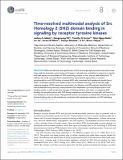| dc.contributor.author | Oh, Dongmyung | |
| dc.contributor.author | Ogiue-Ikeda, Mari | |
| dc.contributor.author | Machida, Kazuya | |
| dc.contributor.author | Yu, Ji | |
| dc.contributor.author | Jadwin, Joshua A. | |
| dc.contributor.author | Curran, Timothy G. | |
| dc.contributor.author | White, Forest M. | |
| dc.contributor.author | Mayer, Bruce J. | |
| dc.contributor.author | Jia, Lin, Ph. D. Massachusetts Institute of Technology | |
| dc.date.accessioned | 2016-05-23T15:38:50Z | |
| dc.date.available | 2016-05-23T15:38:50Z | |
| dc.date.issued | 2016-04 | |
| dc.date.submitted | 2015-09 | |
| dc.identifier.issn | 2050-084X | |
| dc.identifier.uri | http://hdl.handle.net/1721.1/102619 | |
| dc.description.abstract | While the affinities and specificities of SH2 domain-phosphotyrosine interactions have been well characterized, spatio-temporal changes in phosphosite availability in response to signals, and their impact on recruitment of SH2-containing proteins in vivo, are not well understood. To address this issue, we used three complementary experimental approaches to monitor phosphorylation and SH2 binding in human A431 cells stimulated with epidermal growth factor (EGF): 1) phospho-specific mass spectrometry; 2) far-Western blotting; and 3) live cell single-molecule imaging of SH2 membrane recruitment. Far-Western and MS analyses identified both well-established and previously undocumented EGF-dependent tyrosine phosphorylation and binding events, as well as dynamic changes in binding patterns over time. In comparing SH2 binding site phosphorylation with SH2 domain membrane recruitment in living cells, we found in vivo binding to be much slower. Delayed SH2 domain recruitment correlated with clustering of SH2 domain binding sites on the membrane, consistent with membrane retention via SH2 rebinding. | en_US |
| dc.description.sponsorship | National Institutes of Health (U.S.) (Grant U01CA154966) | en_US |
| dc.language.iso | en_US | |
| dc.publisher | eLife Sciences Publications, Ltd. | en_US |
| dc.relation.isversionof | http://dx.doi.org/10.7554/eLife.11835 | en_US |
| dc.rights | Creative Commons Attribution | en_US |
| dc.rights.uri | http://creativecommons.org/licenses/by/4.0/ | en_US |
| dc.source | eLife Sciences Publications, Ltd. | en_US |
| dc.title | Time-resolved multimodal analysis of Src Homology 2 (SH2) domain binding in signaling by receptor tyrosine kinases | en_US |
| dc.type | Article | en_US |
| dc.identifier.citation | Jadwin, Joshua A, Dongmyung Oh, Timothy G Curran, Mari Ogiue-Ikeda, Lin Jia, Forest M White, Kazuya Machida, Ji Yu, and Bruce J Mayer. “Time-Resolved Multimodal Analysis of Src Homology 2 (SH2) Domain Binding in Signaling by Receptor Tyrosine Kinases.” eLife 5 (April 13, 2016). | en_US |
| dc.contributor.department | Massachusetts Institute of Technology. Department of Biological Engineering | en_US |
| dc.contributor.department | Koch Institute for Integrative Cancer Research at MIT | en_US |
| dc.contributor.mitauthor | Curran, Timothy G. | en_US |
| dc.contributor.mitauthor | White, Forest M. | en_US |
| dc.relation.journal | eLife | en_US |
| dc.eprint.version | Final published version | en_US |
| dc.type.uri | http://purl.org/eprint/type/JournalArticle | en_US |
| eprint.status | http://purl.org/eprint/status/PeerReviewed | en_US |
| dspace.orderedauthors | Jadwin, Joshua A; Oh, Dongmyung; Curran, Timothy G; Ogiue-Ikeda, Mari; Jia, Lin; White, Forest M; Machida, Kazuya; Yu, Ji; Mayer, Bruce J | en_US |
| dspace.embargo.terms | N | en_US |
| dc.identifier.orcid | https://orcid.org/0000-0002-1545-1651 | |
| mit.license | OPEN_ACCESS_POLICY | en_US |
